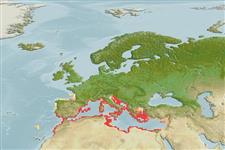Common names from other countries
Classification / Names / Names
Namen | Synonyme | Catalog of Fishes (gen., sp.) | ITIS | CoL | WoRMS
Environment: milieu / climate zone / depth range / distribution range
Ökologie
; tiefenbereich 2 - 60 m (Ref. 104492). Temperate; 46°N - 30°N, 18°W - 37°E
Eastern Atlantic and the Mediterranean. Subtropical.
Length at first maturity / Size / Gewicht / Alter
Maturity: Lm ? range ? - ? cm
Maximum depth from Ref. 106813. Found on muddy sand with seaweed at a depth of 60 m (Ref. 106813). In general, suspension feeding bivalves mainly depend on phytoplankton and detritus material for nutrition (Ref. 107088).
Life cycle and mating behavior
Geschlechtsreife | Fortpflanzung | Ablaichen | Eier | Fecundity | Larven
Members of the class Bivalvia are mostly gonochoric, some are protandric hermaphrodites. Life cycle: Embryos develop into free-swimming trocophore larvae, succeeded by the bivalve veliger, resembling a miniature clam.
Gaspar, M.B., M.D. Dias, A. Campos, C.C. Monteiro, M.N. Santos, A. Chicharo and L. Chicharo. 2001. (Ref. 2714)
IUCN Rote Liste Status (Ref. 130435)
CITES Status (Ref. 108899)
Not Evaluated
Not Evaluated
Bedrohung für Menschen
Harmless
Nutzung durch Menschen
| FishSource |
Tools
Mehr Information
Alter/Größe
Wachstum
Länge-Gewicht
Länge-Länge
Morphologie
Larven
Dichte
Internet Quellen
Estimates based on models
Preferred temperature
(Ref.
115969): 15.3 - 21.5, mean 18.7 (based on 144 cells).
